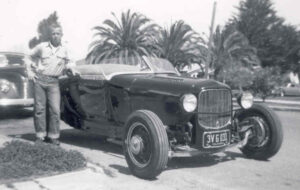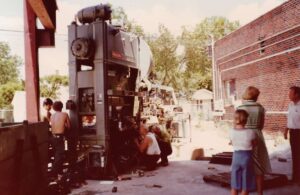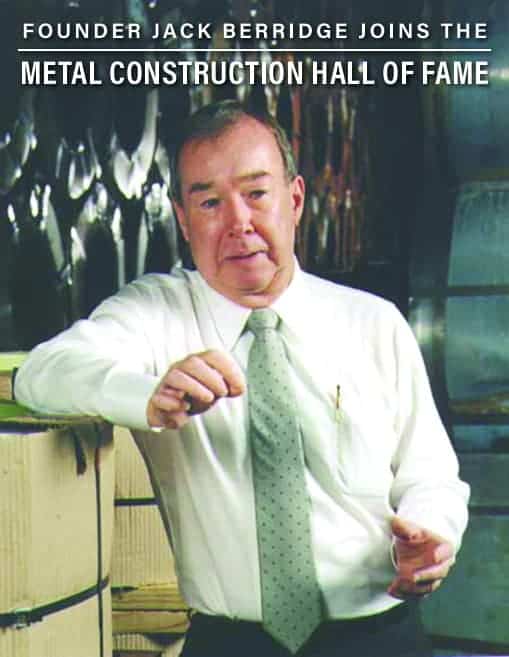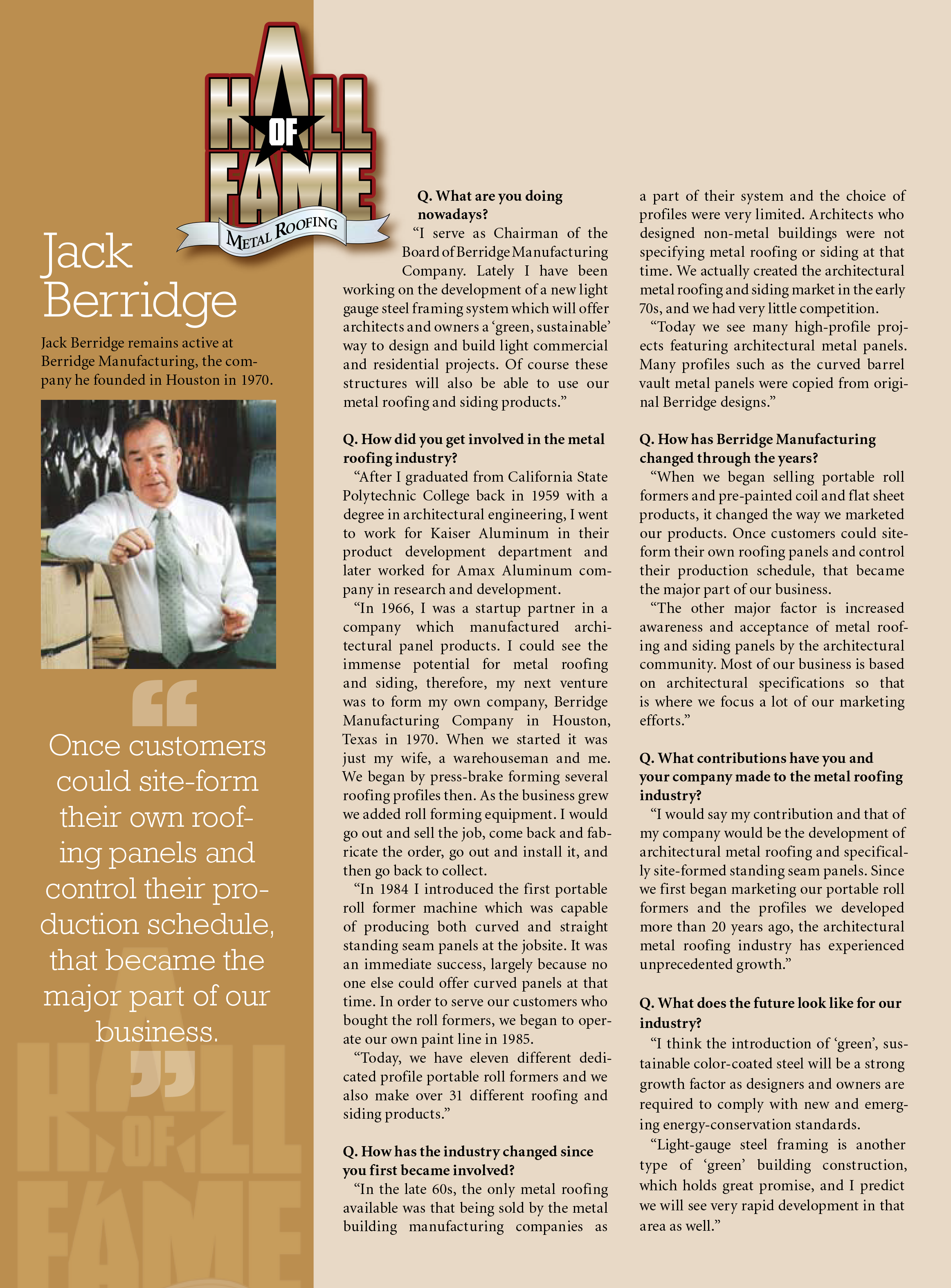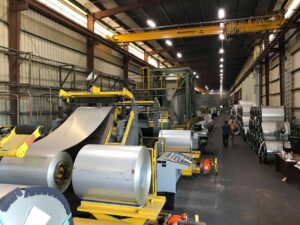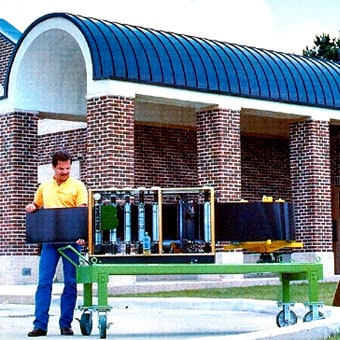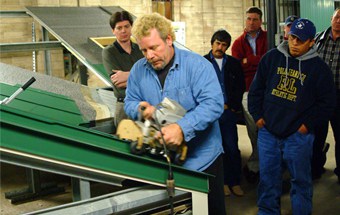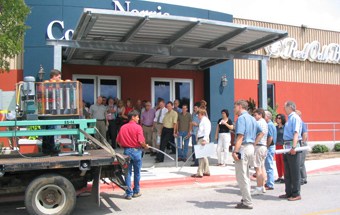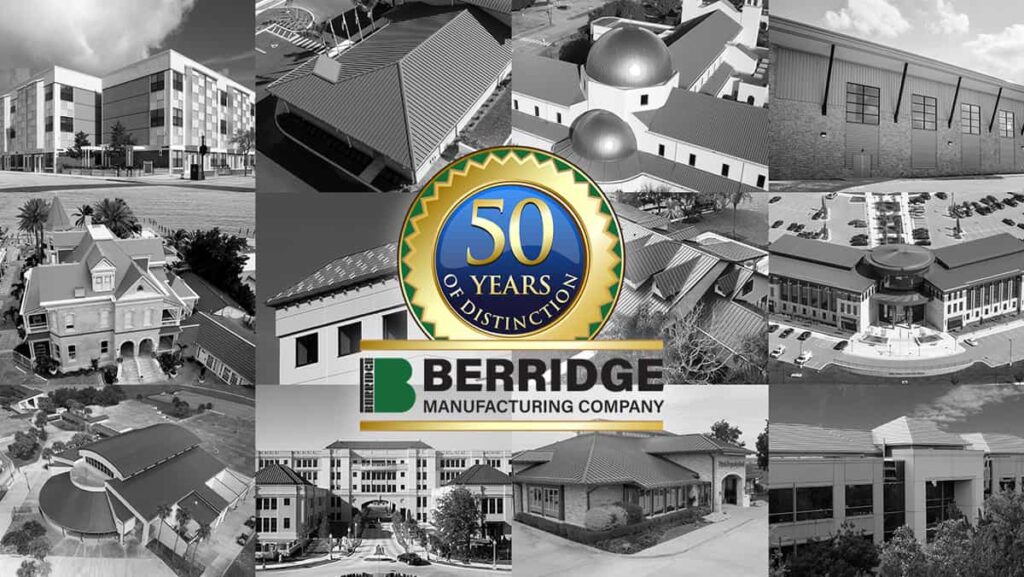
50 Years of Distinction
John Albert “Jack” Berridge was born on March 28th, 1928 in Atchison, Kansas, the youngest of three sons of Guy Harold and Alberta Theresa Koebrich Berridge. While he entered the world at a tempestuous time, a year before the stock market crash that triggered the Great Depression, he grew up in a loving, supportive, small-town atmosphere, nurtured but the security of an extended family. Jack’s fearlessness against risk and importance of values served him well throughout his life as he navigated the cultural shift between small-town Kansas and edgy Southern California during his teen years; to pursuing possible careers as a race car driver and U.S. Air Force pilot; to earning an engineering degree at a time when technology, innovation, and creativity were changing the face of America; and to developing a successful international business that continues to deliver the finest in architecturally engineered products.
In the Beginning
Everything that Jack Berridge accomplished in his life, personally and professionally, led him to the point in the fall of 1970 when he formed Berridge Manufacturing Company. In the beginning, he had one major client, Allred Roofing in Houston; one major supplier for aluminum shingles, AEP; a potential national marketplace; a staff of three, which included himself and his wife; and the drive and vision to find a need and fill it with creatively designed quality products, and competitive pricing.
It was incredibly difficult to start a business from nothing with nothing. “The first Berridge Manufacturing Company building was rented for several years from Steve’s Lumber Company at the corner of Loraine and Maury Street in Houston. It was a small metal building on stilts and it was so cold in that building the first winter, it froze the ribbon on Carol’s typewriter,” said Jack. It was just Carol and Jack at that point. They later hired a helper to unload trucks.
Jack carried an enormous workload being involved in every step. He would sell the job, fabricate the job, install the job, and then go back to collect payment from the contractor or building owner. Every aspect of the business depended on Jack including training personnel, purchasing material and equipment, quality control, design and testing new products, pricing, advertising, and more. Much of his time was answering technical questions from architects and contractors.
As sales increased, Jack hired helpers for fieldwork and shop work and started to fabricate special accessories and flashing for the jobs. But first, he needed a 10-foot leaf break to do that. “I found a used one for $1,200 and a bank to give me a loan for the purchase,” said Jack. “I still say to this day, that was the most difficult loan I ever made because I had no collateral.”
When a full city block came up for sale across the street at 1720 Maury, Jack purchased it. The property had a brick office building and two small metal buildings. The property was fenced off and, through the 1970s and 1980s, they expanded until one roof covered the entire city block. The Houston office is still one of the company’s branch plants today with the Watertightness Warranty and Technical Departments located there.
Jack’s children remember that location well as it was sometimes their second home in their early years. It was truly a family business. Because their mother also worked for the business, handling administrative duties, they set up a playroom in the office. Kim, who today serves on the board of directors, recalls that she worked down there as far back as she can remember. “We used to clean offices on the weekends. I’ve done everything from answering phones to calling on credit to filing to helping do whatever needed doing.”
As involved as Jack was in the design, products, and process, he also knew how important marketing was from the beginning. He put together his first four-page Berridge Manufacturing Company brochure for Sweets Catalog which appeared in the January 1975 edition. “Architects relied on Sweet Catalog for information to specify products so I personally put our entry together because it was so important,” said Jack. Today Berridge provides Sweet’s with a digital catalog for their online catalog.
Over the years at the Houston location, Jack employed many people, some of whom are still with the company. Becky Wynne was hired in 1983 to help with inventory control but soon transitioned into sales. “Becky is a key employee, one of the most knowledgeable people regarding all Berridge Manufacturing Company products,” said Jack. Becky still trains most new Berridge Manufacturing Company employees. Today she is the National Customer Service Manager and is responsible for the Sales Department and Branch Managers.
“Jack always treated women fairly,” Becky adds, “and gave me skills as a leader, showing me how to manage people, and told me that ‘they [meaning customers and staff] don’t have to like you, but they have to respect you and that is your responsibility.’ He never once treated me any differently than the men. Jack is one of the most intelligent men I have ever met and the strongest leader I have ever known.”
Innovation in Design Spurred Business Growth
Research and innovative design directed Jack’s success from the beginning. In 1971, he designed, developed, and began production of the Berridge Tee-Panel standing seam roofing system, a revolutionary design and method of production for custom standing seam roofing.
The Tee-Panel has a 90-degree upright leg and is roll-formed to custom lengths for a building’s needs. The panels are held in place with folding anchor clips attached to the substrate, which allow the panels to move with thermal expansion and contraction. A snap-on seam is used to splice the panels together and was similar in appearance to what was on the market at the time but with much cleaner lines. Because the Berridge Tee-Panel is roll-formed from coil instead of sheets, panels and snap-on seams can be fabricated in continuous lengths from the roof’s eave to ridge, eliminating the horizontal splice of shorter sheets, a major source for leaks. The Berridge Tee-Panel was a pioneering breakthrough in architecturally engineered roofs.
The sales of the Berridge Tee-Panel have been dramatic because of the appearance, quality, style, and ease of installation. Because of this initial success, many companies copied the Berridge Manufacturing Company system and produced and marketed it under different trade names. Ten companies advertised exact copies of the original Berridge Tee-Panel system in the 1986 Sweets Catalog building product resource directory.
To enhance Berridge Manufacturing Company’s competitive edge in a rapidly expanding market, Jack quickly realized that Berridge Manufacturing Company needed a coil coating line of their own in Houston. With its own coil coating line, Berridge could save the market upcharges and freight cost of shipping from the out-of-town paint line. In 1979, Jack purchased a 300-foot coil coating paint line, along with slitters, roll formers, punch presses, and numerous other pieces of equipment, from Jim Lawler in Houston who was getting out of the business. He also purchased a 500-foot long line from Alcoa in Tennessee and moved it to San Antonio, TX.
The next industry breakthrough for the company came in 1983 when Jack developed a snap-on seam with vinyl weatherseal insert for the Berridge Tee-Panel. Leaking metal roofs were an industry challenge in the early days, and Jack was intent on eliminating all leakage problems from his products. In January 1983, he developed a redesigned anchor clip with shorter pre-folded legs, which meant the one upright leg of the panel would be rotated into place under the folded leg of the clip. The shorter legs of the anchor clip then allowed a gasket to have enough room to swell against the upright leg of the roof panel below the anchor clip and form a moisture-resistant splice of panels and seams, completely uninterrupted by the anchor clips. Jack designed an extrusion of vinyl with moisture-resistant ridges to seal against the upright legs of the roof panel to form a watertight seam assembly.
The new Tee-Panel standing seam system was water tested at the Berridge factory and was found to be completely watertight regardless of the amount and direction of the water flow. This breakthrough for a moisture-resistant metal standing seam product was immediately apparent and acceptance grew rapidly with architects and customers.
To protect the company’s snap-on seam with vinyl weatherseal insert from competitors, Jack applied for and received a patent in March 1987.
In 1984, the company acquired the Fratt Road plant in San Antonio from the Schill Steel Company. The following year, Jack installed the Alcoa 60-inch coil coating paint line in this facility. Along with the 42-inch line at the Houston plant, this new line gave Berridge Manufacturing Company increased versatility in prefinished coil sales.
In 1986, Jack again made history by introducing the first portable roll former machine capable of fabricating both straight and curved standing seam panels at the job site. The Berridge Model SS-14 Portable Roll Former, together with pre-finished steel coil material, gave the roofing and sheet metal contractor unprecedented control over the production process and enabled the fabrication of continuous straight or curved barrel vault panels with no end lap splices or fastener penetrations.
“The initial idea for this innovation,” said Jack, “was to make the company more competitive in the marketplace and protect us from the many companies who copied our Tee-Panel and were bidding our own products against us. By concentrating on sales of roll formers we could lock in the customers who bought coil, seams, and fabricated products from us to keep their roll formers busy and their business successful.”
In the face of mounting competition in the late 1980s and the negative selling techniques of competitors running down our products and lowering their prices in order to get more sales and survive, my philosophy with our sales team was simple.
“My response,” said Jack, “to negative statements was to focus on the facts about our products and our high standards for quality. There was no need to cut down the competition. We had the best products on the market and our objective was to ensure our customers understood that.”
Jack was unwilling to compromise his standards on products just to remain competitive but when customers were facing price wars for contracting jobs, he sought innovative ways to help his lessees win their bids by making adjustments in pricing, packaging, and other means.
“We have been successful because we have top quality products, employees, and sales representatives. And we are successful because of innovation. This kind of success draws the attention of competitors and imitators. I don’t think we should share the market that we created. We are going to do everything in our power to make it unprofitable to compete with us,” he wrote in a memo to the sales team on Nov. 15, 1990.
Growth continued into the 1990s and a new 41,000 square foot facility was built on two acres in Seguin in 1993. The facility was initially used as a warehouse and distribution center, but it soon housed all production equipment. By 1999, Berridge Manufacturing Company had 150 employees, plants in Houston, San Antonio, and Seguin, Texas, and branch plants in Denver, Colorado; Atlanta, Georgia; and Chicago, Illinois with a total of 300,000 square feet of plant and office space.
Efficiency, delivering results, and meeting customer needs were at the forefront of his management style. “Jack is a pioneer in the field,” according to Berridge Manufacturing Company President and CEO Joel Jesse. “He started the industry of architecturally engineered roofing. His innovations of a standing seam with concealed fasteners that eliminated leaks, and so much more made the architecturally engineered roofs attractive, economical, and commercially viable. No one handles the breadth of what we do – providing products from the steel mill to the finished product. He was always sensitive to market needs and how to fill them better than his competitors. And his quality products helped make many other companies successful too.”
Jack Berridge continues to be recognized by his peers for his accomplishments. In October 2016, Jack was inducted into the Metal Construction Hall of Fame, sponsored by Metal Construction News magazine, for his influence of the metal construction industry through his creative development of metal building products and equipment and his passion for the business for more than 50 years. The honor also included a full-page article on Jack in the November 2016 issue of Metal Construction News.
The next chapter in Jack’s life, and that of Berridge Manufacturing Company, began in 1999 when Jack announced his retirement. This latest period of his life can best be summed up in a letter from John Norman, a former client, and friend, upon hearing of his retirement. “I always like to see someone live the American dream like you have. Many millionaires have made it in the stock market, in the tech world, etc. but you did it the old-fashioned way, with hard work and innovation. At the same time, you have maintained your integrity. It’s good to know that an honest man can still be successful.”
Growth Strategies into and Beyond the 21st Century
In the 1980s, Berridge had branch offices in Houston, San Antonio, Atlanta, Chicago, and Seguin. Production facilities were located in Houston, San Antonio, and Seguin with slitter and flat sheet production at each of the branches. By 2001, all production was moved from San Antonio to Seguin. All slitters and cut-to-length lines moved from the branch offices to Seguin. Corporate offices were gradually moved from Houston to San Antonio, with Joy Houston and her team remaining in Houston along with the engineering, watertightness, and drafting departments. According to Joel, they continued some production in the Houston facility, but today it mainly serves as a distribution center for customers located in the Houston area.
The relocation of the corporate offices from 1720 Maury Street in Houston to 6515 Fratt Road in San Antonio provided Jack with ample opportunities to utilize his architectural and design talents. “We were building a larger organization and hiring additional staff to take on the workload. We needed offices to house the chief financial officer, the controller, accounting staff, and the larger sales and administrative staff,” Joel remembers. “Jack designed the facilities and his construction crew built out the requirements in a matter of weeks. The San Antonio facility housed all the required personnel in the Fratt Road location until 2016. In Seguin, the production plant comprised two buildings with approximately 250,000 square feet. The buildings have been expanded as additional land was purchased for the project, but as of 2016, the plant is nearing capacity.
During the summer of 2016, it became apparent that the company was outgrowing the existing facilities in Seguin and San Antonio. The office space available to house engineering and administrative staff in San Antonio was becoming increasingly crowded. “We needed to obtain additional space to meet current and future needs. At first, the search was focused on locating raw land on which we could build an office complex. But during this search, we located a 20,000 square foot office building at 2610 Harry Wurzbach Road that seemed ideal for our needs,” Joel said. “Within two months, we purchased the building and have undertaken a buildout of the facilities that will provide a wonderful work home for the many employees assigned there.” He and Jack are especially proud of the fact that this office building will be where many of the Berridge grandchildren will begin their business careers in the industry.
Branch offices also have expanded over the last several years. In 2016, the company’s presence has grown to include 12 branches to serve an expanding customer base. Within the last three years, BMC has purchased locations and added sales staff in Phoenix, Oklahoma City, Kansas City, Tampa, and Fontana, California.
To complement the growth in sales and service, Berridge Manufacturing Company has also replaced, improved, and added product lines and manufacturing, investing millions over the last four years in capital improvements to the paint line, thereby improving product lines, increasing efficiencies, and replacing outdated equipment. “The centerpiece of Berridge’s business equipment is the San Antonio paint line,” said Joel. “We have had a number of excellent professionals in charge of the paint line since 1999, but no one has been more instrumental in maintaining the quality of the line than Grant Gillum.”
“Starting in 2013, we initiated a four-year, $5.4 million project to modernize and upgrade the San Antonio paint line,” said Grant. “Life expectancy of these improvements is at least 25 years. This upgrade allowed us to use the latest pretreatment chemical technology recommended and endorsed by the paint and pretreatment supplier.”
“I have seen tremendous growth in the company since I began working here more than 27 years ago,” said Grant. “We have more than tripled in size, adding many products and distribution locations, and maintaining our position as a market and brand leader in metal roofing and wall panel products. My vision is that the company continues to grow by adding products, production capacity, distribution locations, as well as diversifying. I envision the company staying in the hands of the family to support new generations during their working careers and into retirement. I am very proud of the success of this business and plan to pass on what I have learned from Jack to the next generation.”
Grant is already doing just that with the addition of his oldest son Jimmie to the company. “I am very proud of the company my grandfather has built and the legacy he leaves his children, grandchildren, and now great-grandchildren,” said Jimmie. “With the help of my family, I hope to be able to continue growth for future generations. My vision is to stay on the course that my grandfather started — as a private company that provides the best quality metal building products in the industry, and the best customer service. I hope to be able to contribute to the company gaining market share and providing jobs and prosperity for all stakeholders.”
Jack’s endeavors have been built on entrepreneurship, taking calculated risks, having a long-term focused vision for the future, staying curious about possibilities, and the willingness to adapt to change and challenges, character traits he hopes will pass to future leaders of Berridge Manufacturing Company and of the Berridge family.

